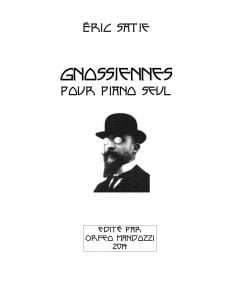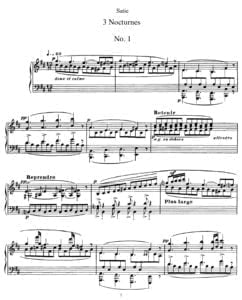Come join us now, and enjoy playing your beloved music and browse through great scores of every level and styles!
Can’t find the songbook you’re looking for? Please, email us at: sheetmusiclibrarypdf@gmail.com We’d like to help you!
Table of Contents
Erik Satie – Gymnopédie no. 1 avec partition musicale (sheet music, Noten)
ERIK SATIE

Born in Honfleur on May 17, 1866, died in Paris on July 1, 1925.
Satie spent his childhood in Honfleur. After the death of his mother, he was raised by his grandparents.
Satie takes organ lessons with an uncle. In 1879-1886, he joined his father, a shipping broker, in Paris.
He enters the conservatory of Paris and follows the courses of Descombes, Taudou, Mathias, perhaps of Lavignac.
In 1886, he composed Ogives, for the piano. From 1887, he adopted the Montmartre life. The Trois Gymnopédies date from 1888, the Trois Gnossiennes from 1890.
From 1891 to 1895, Satie experienced a rather enigmatic period of membership in the Rose-Croix movement of Joseph Péladan, which bears the title of “Sâr”.
In 1891, Erik Satie composed the Trois Préludes du Fils des étoiles “Wagnerie Kaldéenne” to a text by Péladan. We will make this work a source of inspiration for Pelléas de Debussy.
In 1892-1893, he composed the Sonneries de la Rose-Croix and the Gothic Dances (writing without barlines, use of parallel 9th and 11th chords) and in 1895, the Messe des Pauvres for choir and organ.
Please, subscribe to our Library.
If you are already a subscriber, please, check our NEW SCORES’ page every month for new sheet music. THANK YOU!
Satie engages as a pianist in the cabarets of Montmartre. Cold Pieces for piano (1893), pantomime Jack in the box (1899) and a small opera for puppets, Geneviève de Brabant (1899), in three acts, each of which lasts less than five minutes.
Erik Satie moved to Arcueil around 1898. In 1905 he entered the Schola Cantorum, and studied composition and counterpoint with Vincent d’Indy, Roussel and Sérieyx. Around 1910, he got closer to innovators like Diaghilev, Picasso, Cocteau.
Secular and instantaneous hours; Sports and Entertainment (1914) for piano. In 1917, he wrote the music for Parade, a ‘realistic ballet’ based on an argument by Cocteau, sets and costumes designed by Picasso, choreography by L. Massine, represented by Diaghilev’s Ballets Russes.
He composed Socrate, certainly his masterpiece, in 1918. In 1924, that of Relâche ‘instantaneous ballet’, on an argument by Francis Picabia, with a cinematographic interlude by René Clair (Entracte), a choreography by Jean Borlin, with Rolph de Maré’s Swedish Ballets. The same year we give Mercure, in decorations by Picasso and with a choreography by Massine.

Satie is a figurehead of the avant-garde and two groups recommend each other by his authority. The Group of Six and the School of Arcueil. Engaged in social life, he raises funds and organizes snacks for underprivileged children. He wrote several articles for the newspaper l’Humanité, but felt that his Bolshevik comrades were no better than the bourgeois.
Erik Satie had a brother, a shipping broker, but also a sister, Olga (Louise-Olga-Jeannie), born June 17, 1862. She was also a pianist. She marries a doctor, gives birth to a boy, who is taken away from her by a family council after the death of her husband. She went to Argentina in 1900, fixed in Buenos Aires, gave piano lessons and played in hotels. Olga Satie died in 1948.
Erik Satie in 10 dates :
- 1866: Birth in Honfleur
- 1879: Admitted to the Paris Conservatory
- 1887: Move to Montmartre
- 1888: Gymnopédies (composition)
- 1889: Gnossiennes (first publication, the last being in 1897)
- 1898: Installation in Arcueil
- 1903: Three Pear-Shaped Pieces (composition)
- 1917: Parade (ballet, creation)
- 1924: Break (ballet, creation)
- 1925: Death in Paris
Browse in the Library:
Or browse in the categories menus & download the Library Catalog PDF:
